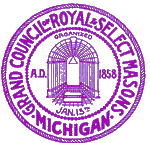While eminent Masonic scholars have frequently disagreed with the exact history of the formation of the Cryptic degrees, there is at least some general information on the degrees with which most Masonic historians will agree. It is on this information that we will concentrate here.
The degrees of Royal and Select Master were not originally combined into one system, each having been conferred by separate parties and initially controlled by separate Councils. As near as may be determined from conflicting claims, the Select degree is the oldest of the Rite. It was customary to confer the Royal degree on Master Masons prior to the Royal Arch, and the Select degree after exaltation to the sublime degree. This accounts for the fact that control of the Cryptic degrees vacillated back and forth in many jurisdictions, even after the formation of Grand Councils. To this date, the Royal and Select degrees are controlled by Grand Chapter in Virginia and West Virginia, and conferred by subordinate Chapters in those jurisdictions.
The Royal degree appears to have been developed primarily in New York under direction of Thomas Lownds, whereas the Select was vigorously promulgated by Philip Eckel in Baltimore. It is claimed by Eckel that a Grand Council of Select Masters was formed in Baltimore in 1792, while it is definitely known that a Grand Council of Royal Masters (Columbian No. 1) was organized in 1810 in New York. It remained for Jeremy Cross to combine the two degrees under one system, which occurred about 1818, and this pattern was adopted in most jurisdictions as the degrees became dispersed beyond the eastern seaboard.
The degree of Super Excellent Master is not allied to the other two degrees of the Cryptic Rite, so far as its teachings and traditions are concerned. The records of St. Andrews Chapter in Boston indicate that a degree of this name was conferred during the latter part of the eighteenth century. The earliest positive reference to the Super Excellent in connection to the Cryptic Rite is December 22, 1817, when a “Lodge” of Super Excellent Masters was organized by Columbian Council of Royal Masters in New York. The incidents, teachings, and ritualistic format of the Super Excellent degree bear no resemblance in any former degrees so named, which appears to justify the claim that it is American in origin. This degree has been, and to some extent still is, a rather controversial subject. It is conferred as one of the regular Cryptic Rite degrees in some jurisdictions, whereas the others confer it as an honorary degree only; in some instances, separate Grand Councils of Super Excellent Masters have been formed. The Grand Council of Michigan adopted the degree in 1872, but it was not generally accepted until after 1917, when the dramatized version replaced the “horse play” commonly in vogue prior to that time. Since then, the conferring of this degree in full form has become mandatory in our Grand Council regulations before a Companion is entitled to full membership.
